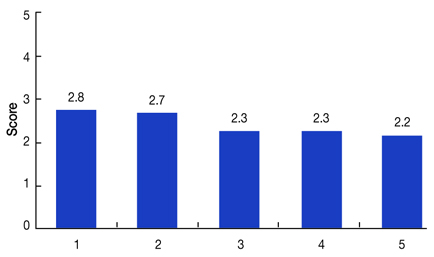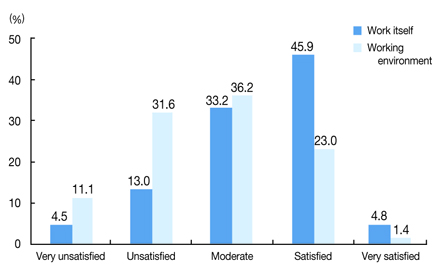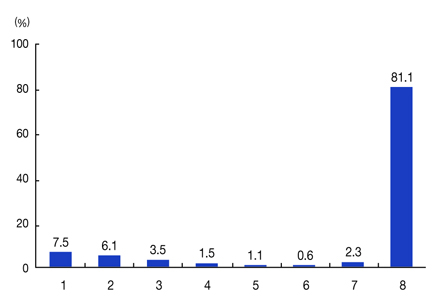J Korean Med Assoc.
2012 Nov;55(11):1128-1141.
A survey on the education, medical practice, research, and fringe benefits of Korean medical school faculty
- Affiliations
-
- 1Research Institute of Healthcare Policy, Korean Medical Association, Seoul, Korea.
- 2Department of Neurology, Yonsei University College of Medicine, Seoul, Korea.
- 3Department of Obstetrics and Gynecology, Dankook University College of Medicine, Cheonan, Korea.
- 4Department of Preventive Medicine, Soonchunhyang University College of Medicine, Cheonan, Korea. parky@sch.ac.kr
Abstract
- In general, medical school faculty have to perform clinical practice in addition to their educational and research activities, unlike the professors of other departments, while simultaneously playing an important role within the medical profession. However, some organizational or environmental factors decrease the job satisfaction of medical professors. This study aimed to determine the current status of medical schools professors' job activities, satisfaction level, factors related to job satisfaction, and so on. A structured questionnaire was used in the survey and 936 valid responses (response rate, 79.1%) were analyzed using SAS version 9.1. Items included in the questionnaire were work tasks, satisfaction with work and environment, fringe benefits, and future plans. Our study found that the satisfaction of respondents with research activities was not high, and they had negative perceptions of their work environment. Also, it was found that job satisfaction was most affected by work environment. In the section on fringe benefits, a variety of fringe benefits were provided to respondents but their actual satisfaction was not high. To enhance the overall job satisfaction of medical school faculty, all the matters related to their work tasks and environmental factors have to be considered in the aspect of their own role in medical school. The limitations of this study were a low response rate to the early online survey and a long duration of the survey period. However, these limitations were resolved by an additional mail survey modality and statistical techniques. It is meaningful that this study was an extensive survey aimed at medical school faculty and dealt with a comprehensive range of issues.
MeSH Terms
Figure
Reference
-
1. Kim KH, Park JH. The perception of medical students for medical education and medical treatment. J Korean Med Assoc. 1999. 42:234–237.
Article2. Center for Education Statistics. Educational statics service. 2011 Statistical yearbook of education: the number of professors [Internet]. cited 2012 Jun 10. Seoul: Korean Educational Development Institute;Available from: http://cesi.kedi.re.kr/index.jsp.3. Kim S. A study on improvement of teaching and learning in Yonsei University College of Medicine. Korean J Med Educ. 1998. 10:293–307.
Article4. Park YH, Yoon HB, Jeon SG, Kim HJ, Kim KS. Research on the satisfaction of professors in medical colleges. 2004. Seoul: Research Institute for Healthcare Policy, Korean Medical Association.5. Lee YS, Chae SJ, Shin JS. Faculties in Korean medical schools: their specialties and inbreeding. Korean J Med Educ. 2004. 16:269–279.
Article6. Gilmore TN, Hirschhorn L, Kelly M. Challenges of leading and planning in academic medical centers. 1999. Philadelphia: Center for Applied Research.7. Lee YS, Oh DK, Kim M, Lee YS, Shin JS. Exploration of a leadership competency model for medical school faculties in Korea. Korean J Med Educ. 2010. 22:313–321.
Article8. Nyquist JG, Hitchcock MA, Teherani A. Faculty satisfaction in academic medicine. New Dir Inst Res. 2000. 2000:33–43.
Article9. Kim S, Lee MS, Chung MH, Ohrr HC. A study on educational accountability of faculty in medical schools. Korean J Med Educ. 2002. 14:245–256.
Article10. Reed LE. Determinants of faculty job satisfaction and potential implications for physician assistant program personnel. J Physician Assist Educ. 2006. 17:30–35.
Article11. Association of American Medical Colleges. Medical faculty job satisfaction: thematic overviews from ten focus groups. 2006. Washington, DC: Association of American Medical Colleges.12. Bunton SA, Corrice AM. Job satisfaction of US medical school faculty with a focus on internal medicine departments. Acad Intern Med Insight. 2008. 6:8–9. 1513. Bunton SA, Corrice AM, Mallon WT. Clinical faculty satisfaction with the academic medicine workplace. 2010. Washington, DC: Association of American Medical Colleges.14. Flanigan TS, McFarlane E, Cook S. Conducting survey research among physicians and other medical professionals: a review of current literature [Internet]. 2008. cited 2012 Oct 9. Deerfield (IL): American Association for Public Opinion Research;Available from: http://www.amstat.org/sections/srms/proceedings/y2008/Files/flanigan.pdf.
- Full Text Links
- Actions
-
Cited
- CITED
-
- Close
- Share
- Similar articles
-
- Is the Pass/Fail System Applicable to a Medical School in Korea?
- Evaluating knowledge retention and perceived benefits of medical webinar for professional development among Indonesian physicians
- Current status and needs of community-based practice in public healthcare institutions among Korean medical schools: a cross-sectional study
- An Analysis of Course Evaluation Programs at Korean Medical Schools
- Medical students in Indonesia: an invaluable living gemstone during coronavirus disease 2019 pandemic






